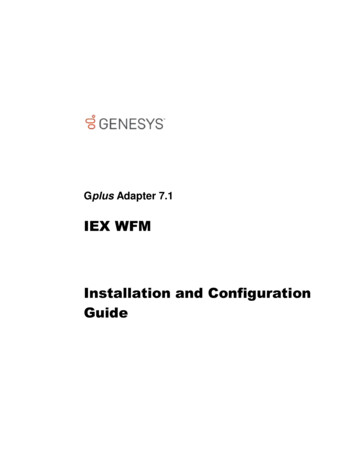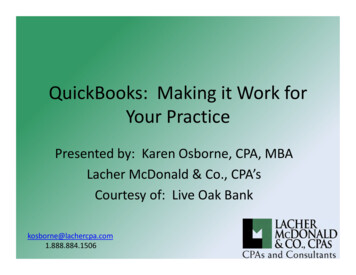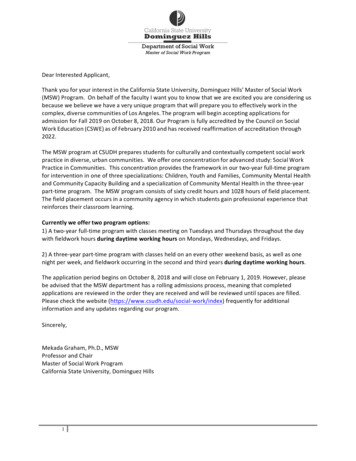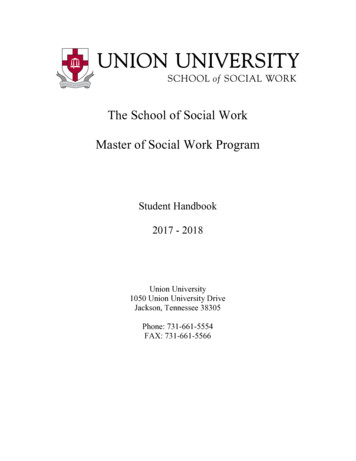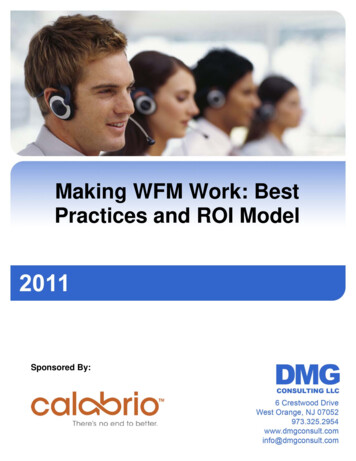
Transcription
The Power of Real-Time Delivery:Using Agent Idle Time to Improve ServiceMaking WFM Work: BestPractices and ROI ModelSponsored By: 2011 DMG Consulting LLCAll rights reserved.-1-April 2011
Making WFM Work:Best Practices and ROI ModelExecutive SummaryThe contact center workforce management (WFM) market has finally come to life.Contact center leaders have had a “love/hate” relationship with WFM since it was firstintroduced in the 1970s. Managers knew they needed WFM to minimize their agentrelated costs, but were frustrated by the complexity of these mission-critical applications.It took 30 years, but contact centers of all sizes now have a growing number of effectiveWFM solutions from which to choose.A new generation of compelling and easier-to-use WFM solutions has recently enteredthe market. This new class of contact center WFM solutions is designed for managers toreadily apply and realize immediate benefits. They come with self-service modules thatempower agents, changing the dynamics of contact centers and freeing supervisors todedicate their time to helping customers instead of managing agent schedules. Thesenew WFM solutions are making major contributions to contact centers, yieldingquantifiable agent productivity improvements of up to 30% for first-time WFM users and5% to 8% for companies replacing an outdated WFM solution.IntroductionWorkforce management solutions forecast contact center transaction (call, email andSMS) volumes and identify the best work schedules to ensure that the right number ofagents can be hired to address incoming and/or outgoing traffic at a pre-determinedservice level. When used properly, WFM solutions are the most important productivitytools in contact centers. They are essential for any contact center with more than 100agents, and in smaller centers with complex he adoption rate of WFM is still surprisingly low, once you look beyond contact centerswith more than 500 agents. Many contact centers of all sizes are still not using packagedWFM solutions for three primary reasons:1. WFM solutions have traditionally been very costly2. WFM solutions have traditionally been difficult and almost painful to use3. WFM solutions are not accurate enough to make them worth the cost andeffortOver the last three years, there has been tremendous innovation in contact center WFMsolutions. New vendors and offerings have come on the scene, giving end users manygood choices and new capabilities. The new-generation WFM solutions are also mucheasier to use. If you have not explored WFM solutions in the past three years, this is agood time to consider an investment in a solution that can reduce agent-relatedexpenses, improve agent satisfaction and enhance the customer experience. 2011 DMG Consulting LLCAll rights reserved.-1-April 2011
Making WFM Work:Best Practices and ROI ModelIdentifying WFM Benefits for Your Contact CenterWhen a WFM solution is used and applied consistently, it is a mission-critical application.The benefits go far beyond efficiency and effectiveness, as a next-generation WFMsolution can and should be used to alter how contact centers manage their relationshipswith agents. Relations can become strained if agents feel they are being mistreatedwhen schedules vary due to fluctuations in transaction volumes, even if they agreed toaccept schedule changes as a condition of being hired.Figure 1 provides a list of benefits that contact centers can realize from a successfulWFM implementation. DMG always recommends building a business case using onlyquantifiable benefits (also call “hard” benefits), but including both hard and softenhancements when explaining the solution to agents. Often the qualitative or “soft”benefits have a more far-reaching impact; however, it is extremely difficult to place aprice tag on “soft” benefits, and therefore chief financial officers and controllers aregenerally not willing to accept them in a return on investment (ROI) analysis. 2011 DMG Consulting LLCAll rights reserved.-2-April 2011
Making WFM Work:Best Practices and ROI ModelFigure 1: Proven WFM BenefitsProductivity Reduces non-productive agent time Increases agent adherence Improves agent occupancy/utilization rates Reduces interaction handling time by using skill-based scheduling Reduces shrinkage and absenteeism Reduces time supervisors spend scheduling/reportingEfficiency Improves service levelsOptimizes staffing in global, virtual and at-home agent environmentsProvides real-time visibility to react to shifting volumeEnables pre-planning for loss of coverage and other schedulinganomaliesImproves visibility into key performance indicatorsEnhances ability to cost-effectively manage multiple sitesImproves planning and budgeting for recruitment and hiringProvides ability to run "what if" planning scenarios to find optimal schedulesImproves performance of multi-channel, multi-skill, and blended environmentsCost Reduction Reduces agent over-staffing/under-utilizationImproves first call resolutionReduces agent attritionProvides flexible scheduling alternatives that allow users to meetvolume demandsOptimizes schedules around paid time off, scheduled off-phone activities, etc.Reduces administration time for supervisory overhead by automatingpayroll/administrationAllows more accurate planning and budgeting, reducing need to overstaffImproves intra-day management of queue volumes, staffing levels andexception managementReduces overtime and telecom costsReduces facilities and real estate costs as a result of optimized seatassignments and ability to effectively schedule/manage at-home agents 2011 DMG Consulting LLCAll rights reserved.-3-April 2011
Making WFM Work:Best Practices and ROI ModelCustomer Satisfaction Reduces abandonment, call-backs, holds and transfers Reduces wait timesStaff Satisfaction Minimizes complaints regarding unfair handling and favoritism in agentscheduling Empowers agents to manage their own schedules Accommodates agent schedule preferences, improving chances thatagents are available at assigned times Reduces administrative time (and headaches) involved in manual scheduling Improves information available for performance management Improves agent motivation by establishing a ranking system that givesschedule preferences to the best performers Provides a more effective method for managing non-phone and trainingactivitiesRevenue Generation Increases sales revenue and conversion rates Increases ability to meet revenue/collections goals due to higher connect andright-party connect rates, and by staffing with the right agentsRegulatory Compliance / Risk Mitigation Improves ability to comply with regional, state, country, union or labor lawsand restrictionsAfter identifying the benefits and costs for a WFM solution, prospects should build abusiness case to justify their investment so that they can obtain project approval andfunding. (The vendor will need to provide the costs.) The business case should explainthe reason the WFM solution is needed; include an ROI model that quantifies thebenefits and shows the payback period, return on investment and net present value forthe WFM solution; and discuss the project time frames. Contact centers of all sizesshould be able to realize significant and quantifiable benefits that will justify theinvestment.Figures 2 and 3 are example ROI models for first-time and replacement WFM solutions,respectively. Both of these models address a contact center where there are 200 fulltime equivalents (FTEs), but 250 agents, in a single site that handles only phone calls.The difference in the two models is the amount of projected savings. The first time acontact center moves from doing WFM manually, via spreadsheets or the not-at-alluncommon “gut” estimate approach, to a packaged WFM solution, the FTE savings are 2011 DMG Consulting LLCAll rights reserved.-4-April 2011
Making WFM Work:Best Practices and ROI Modelgenerally 20% to 30%. Part of the challenge is sustaining these benefits. This is where areplacement WFM solution can make a substantial contribution to a contact center,making it easier for them to sustain previously realized benefits and delivering enhancedfeatures that incrementally build on the prior savings. Companies that implement areplacement WFM solution should expect a 5% to 8% decrease in operating costs,depending upon the quality of the existing WFM implementation and how well the nextgeneration WFM solution is used and applied.Figure 2: First-Time WFM ImplementationSolution CostsCostWFM software license fees 130,000Hardware expenseInstallation/training/professional services7,00030,000One-time installation costsAnnual maintenance and support (18% of software list price) 167,000 23,400Annualized Savings/BenefitsSavingsReduced agent overstaffingImproved agent adherenceImproved supervisor efficiency (from agent self-service)Reduced agent overtime expenseReduced agent turnover/churn 1,000,00062,50030,00020,00020,000Total 1,132,500ROI MeasuresPayback Period (months)1.81Internal Rate of Return663%Net Present Value (3 years @12%) 2,496,871In the ROI model in Figure 2, the one-time costs for the WFM solution are 167,000. Theongoing annual maintenance cost is 23,400. However, since the benefits and savingsfrom the solution are 1,132,500 annually, the payback period for this first-time user isonly 1.81 months. Even if there is a slight delay in realizing the benefits as managers getacclimated to the system, it will pay for itself within 2 to 3 months. This results in aninternal rate of return of 663% and a net present value of 2,496,871, assuming a 12%cost of funds over a 3-year period. Even with most stringent financial approvalthresholds, this WFM investment should be easily approved. 2011 DMG Consulting LLCAll rights reserved.-5-April 2011
Making WFM Work:Best Practices and ROI ModelFigure 3: Replacement WFM ImplementationSolution CostsCostWFM software license feesHardware expenseInstallation/training/professional services 130,0007,00030,000One-time installation costsAnnual maintenance and support (18% of software listprice) 167,000Annualized Savings/BenefitsSavingsReduced agent overstaffing 250,000Improved agent adherence25,000Improved supervisor efficiency (from agent self-service)9,000Reduced agent overtime expense5,000Reduced agent turnover/churn6,000Total 23,400 295,000ROI MeasuresPayback Period (months)7.38Internal Rate of Return153%Net Present Value (3 years @12%) 485,337In the ROI model in Figure 3, the one-time costs for the replacement WFM solution andannual maintenance are the same as in Figure 2: 167,000 and 23,400, respectively.However, the benefits are expected to be less because this contact center should havealready realized significant improvements when they installed their first WFM solution.As a result, the savings realized from a replacement WFM solution are projected to beapproximately 295,000 annually. The payback period is expected to be 7.38 months.The replacement WFM solution is expected to yield a 153% internal rate of return andhave a net present value of 485,337, assuming a 12% cost of funds over a 3-yearperiod. As most enterprises prioritize projects that pay for themselves within 9 to 12months, this investment should be approved.Tips for Increasing Benefits from WFM SolutionsFigures 2 and 3 above show five typical benefits that contact centers realize when theyimplement a WFM solution. The categories and projected savings for first-time WFMimplementations and replacement solutions are: 2011 DMG Consulting LLCAll rights reserved.-6-April 2011
Making WFM Work:Best Practices and ROI ModelWFM Savings CategoryReduced agent overstaffingImproved agent adherenceImproved supervisory efficiency (fromagent self-service)Reduced agent overtime expenseReduced agent olution20%1.25%5%5%.5%1.5%20%20%5%3%To realize these savings, DMG offers the following tips:1. Reducing agent overstaffing – change employees from full-timers to part-timers.This is hard to do with long-time employees, which is why organizations thatneed to transition a portion of their staff to part-time schedules often do so asthey hire new staff members. DMG also recommends using incentives tomotivate long-term staff members to alter their schedules. This may includeoffering at-home opportunities or more overtime to encourage employees to bemore flexible about their hours.2. Improving agent adherence – remind agents that a schedule change is comingup; this has proven to be a highly effective way of improving agent scheduleadherence. DMG recommends using the WFM application to send alerts or topost schedules to agents’ Microsoft Outlook calendars. Additionally, it’s essentialto share adherence information with agents on a timely basis. This means thatsupervisors should discuss out-of-adherence situations with agents as they occur,instead of waiting to “punish” them after a series of such events. If an agentdemonstrates a pattern of lateness in the morning, for example, it could very wellbe due to a transportation issue. A supervisor should discuss this with the agentas soon as the pattern is recognized, and, if need be, change the agent’sschedule to accommodate their transportation needs.3. Improving supervisory efficiency – train and encourage agents to use the selfservice feature of the WFM solution to request preferred schedules, swapschedules or hours, or request time off and vacations. We further recommendthat, whenever possible, contact centers use the automated approval features inWFM solutions to approve agent requests. Giving agents instant gratification willencourage them to use the self-service application. It will also free supervisorsfrom having to invest their time in managing schedule preferences and vacationrequests. In doing so, it will help improve agent satisfaction and alleviate claimsof supervisor favoritism because approvals will be granted by the applicationusing standardized criteria. 2011 DMG Consulting LLCAll rights reserved.-7-April 2011
Making WFM Work:Best Practices and ROI Model4. Reducing agent overtime expenses – run forecasts more frequently in order toreduce the amount of overtime that your department incurs. It also helps to usethe intra-day WFM module on a consistent basis to do a better job of anticipatingwhen additional agent resources are going to be needed. The intra-day capabilitywill show the hours when you’re going to have the biggest needs, and can beused to shift resources from less important tasks, such as a team meeting, toaddress unexpected surges in call volume. The real trick is to combine the twoactivities – running forecasts weekly and using the intra-day functionality at a settime every day – to better anticipate last-minute needs. Another tip is to have agroup of flexible agents who are willing to swap future hours for additional hourson a current day. Use the self-service feature to accommodate theserequirements.5. Reducing agent turnover/churn – make reducing agent turnover a priority, as itcosts approximately 5,000 to replace and train a new agent. One of the primaryreasons agents leave contact centers is because they do not receive consistentfeedback and coaching. Therefore, DMG recommends that managers use theirWFM solution to schedule periodic coaching sessions with agents; thesesessions should be mandatory. Agents can also benefit from WFM solutions thatenable them to monitor their own performance metrics. What agents want is tobe treated fairly, and WFM applications can make major contributions towardachieving this goal. Use the automated self-service approval process to grantschedule swaps and vacation requests. The WFM solution can also be used toaward top performers by giving them priority for prime schedules or shifts.However, when you utilize the WFM solution in this way, it’s essential to informeveryone – agents and supervisors – that it’s happening, so that the staff willappreciate the inherent fairness of the newly applied rules.These are just five of the many ways for contact centers to realize significant andquantifiable benefits from a WFM solution. By promoting fairness through the applicationof an automated schedule approval process that is based on work rules, WFM solutionsgo well beyond simply reducing agent overstaffing. They also empower agents to controltheir own schedules, and give them the freedom to request schedule changes or time offwithout having to plead with supervisors. These “‘soft” benefits may be hard to quantifybut go a long way in improving agent and supervisor satisfaction. The result is happieragents who are more committed to your organization and customers.WFM Application Selection CriteriaThe returns from WFM have been inconsistent over the years, largely because many ofthe solutions were so hard to utilize that end users either gave up and did nothing (whichis worse than using spreadsheets) or ran it just once or twice a year. Both of theseapproaches are sub-optimal and can actually defeat the purpose of using WFM. Below isa list of WFM criteria that should be used to assist your department in deciding whether 2011 DMG Consulting LLCAll rights reserved.-8-April 2011
Making WFM Work:Best Practices and ROI Modelto consider acquiring a new or replacement WFM solution. If you answer “yes” to 6 ormore of these questions, a new WFM solution will likely deliver an attractive paybackand improve your customer and agent experience.Yes / NoAre you currently doing forecasting and scheduling manually or with thehelp of spreadsheets?Is your current solution so difficult to use that it is only run once or twicea year?Does your current WFM solution require an expensive analyst to operatethe application?Is the user paradigm and interface of your WFM application very datedand time-consuming to use?Does your current WFM solution need to be loaded and maintained in athick client?Has your vendor sunset the current version of your WFM solution andwill no longer support it?Is intra-day management a challenging and complex task that requiresusers to access many screens?Would a feature-rich agent self-service module with an automatedapproval process improve agent and supervisor satisfaction?Is it very challenging to schedule in conformance with work or unionrules in your current environment?Is forecasting for social media transactions outside the scope of yourcurrent solution?Does your current solution allow you to meet your service level withoutoverstaffing?Final ThoughtsFor the past 30-plus years, WFM solutions were often regarded as the mostdisliked application in contact centers because they were so difficult to use. Noone debated the value and contributions of a WFM application; the only issuewas whether it was worth the time and effort required to realize the benefits from 2011 DMG Consulting LLCAll rights reserved.-9-April 2011
Making WFM Work:Best Practices and ROI Modelthese systems. As a result, WFM solutions were used predominantly by largecontact centers that were able to dedicate highly skilled (and often expensive)resources to use this application. The negative perception of WFM exacerbatedthe problem of slow adoption, as vendors were reluctant to spend on R&D fornecessary improvements because they were concerned that they would see littlereturn on their investment. As a result, only the most highly committed contactcenters were willing to use these challenging, but highly beneficial applications.Although it has taken far too long, the situation has recently changed, as newvendors have introduced much more usable WFM solutions to the market. Now,for the first time, contact centers of all sizes can find WFM solutions thatmanagers can readily learn and apply, and that are priced right for their operatingenvironment. Workforce management is not a simple concept, but with the rightapplication, contact cen
The contact center workforce management (WFM) market has finally come to life. Contact center leaders have had a “love/hate” relationship with WFM since it was first introduced in the 1970s. Managers knew they needed WFM to minimize their agent-related costs, but were frustrated

